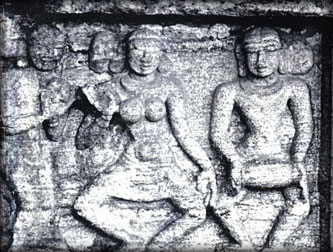Yapahuva, ideal place for dance research
by Subashini Pathmanathan
Yapahuva is in the Kurunegala district. It is nearly three kilometres
east of Maho. The earlier glory of this ancient citadel can be found at
one of the caves. This is seen from a short record in Brahmi script. The
Brahmi language was in use from the 3rd century B.C to the 3rd century
AD.
 |
|
A scene fromYapahuwa. |
Yapahuva gained prominence after the first half of the 13th century
A.C, specially after the Kalinga Magha devastated the capital
Polonnaruva. Kalinga Magha ruled from 1214 to 1235. Earlier Yapahuva was
known as Subha-Pabbata meaning auspicious mountain. According to history
during the reign of Vijayabahu 1V (1271-1273A.C) the place was called
Sundarapabbata. According to historical evidence king Vijayabahu 1V
commanded his younger brother Bhuvanekabahu to settle there with his
strong army to prevent the South Indian invasion. Despite his heavy
guard the attack came from another direction led by Chandrabhanu in
co-operation with his Pandya and Chola allies. Yet numerous historical
records reveal that Yapahuva had a long history.
Portuguese
In the 16th century the Portuguese referred to Yapahuva as the
fortress of the Sinhalese. The first serious study of Yapahuva was done
by John Bailey in 1850. In 1864 he published an article on Yapahuva. On
May 5, 1877 an architect from Anuradhapura mentioned Yapahuva to the
Governor W.H. Gregory by indicating that more attention should be paid
to it.
Again after 15 years, the Royal Asiatic Society published two
articles by F.H. Modder and J.Harward under the title 'Note on the
Fortifications of Yapahuva. Yapahuva is a stone structure. There is a
staircase flanked and decorated by two stone-made lions with an
attractive porch set against the famed Yapahuva rock.
Still it is considered one of the finest ancient archaeological
constructions of Sri Lanka during the post-Polonnaruva period.
The Archaeological Department commenced operations in 1911. The first
Commissioner of Archaeological Department H.C. Bell took great interest
to protect the constructions from destruction.
Today Yapahuva provides ample evidence for carved ancient sculptures
of Sri Lanka. Excellent carved sculptures are seen all over. Beautiful
dance figures are carved in Yapahuva. The carved figures including
dancing girls, lions, swans and elephants are seen at Yapahuva.
It also provides an opportunity to compare these dance figures with
the poses of Indian classical dances especially with the dancing figures
of Chidambaram temple and stone carving sculptures) and Chola
architectural sculptures.
However, there is no doubt that it was further modified according to
the Sinhalese architecture style by local craftsmen.
Dancing figures
Beautifully carved dancing figures are seen at the staircase. Even
Kirti Mukha (head of a mythical creature and a pair of Gaja Sinha are
seen there). The base of the porch area is decorated with beautiful
female and male dancing figures. The dancing figures depict numerous
dance poses. The carved figures not only depict the dance poses but also
numerous instrumental accompaniments for dance.
It implies that during that period the dances took place with
instrumental music. And also it provides an opportunity for us to assume
that dancing carved figures reveal some scenes of dance processions. The
staircase can be divided into three different sections. At the third
level, beautiful slender female figures are seen.
The stairway leading to the porch is well preserved. At both sides
exquisite craftwork windows can be seen. Such excellent windows are not
seen elsewhere in Lankan archaeological sites. The window in the west
was removed a few years back and it is said that it was brought down to
the Colombo Museum. The other was a small fragment window which was
taken to one of the Yapahuva temples.
The window was fitted into a thick outer frame. Within the moulded
window, 45 cut circles were crafted. These cut circles were joined with
one another. Within the circles a variety of figure works was crafted
with meticulous care. Different dance figures of dancers were seen. Most
of these dance figures are seen in typical Bharatha Natya Arimandi
Isthana position. All the dance poses are seen with a proper and perfect
geometrical format position. The centre of this window circle carries a
lotus figure. At the sides of the centre lotus circle four wheels are
seen with eight strokes and some circles are decorated with dancing
figures. Hence for the dance research, Yapahuva provides a great deal of
information for researchers. |

